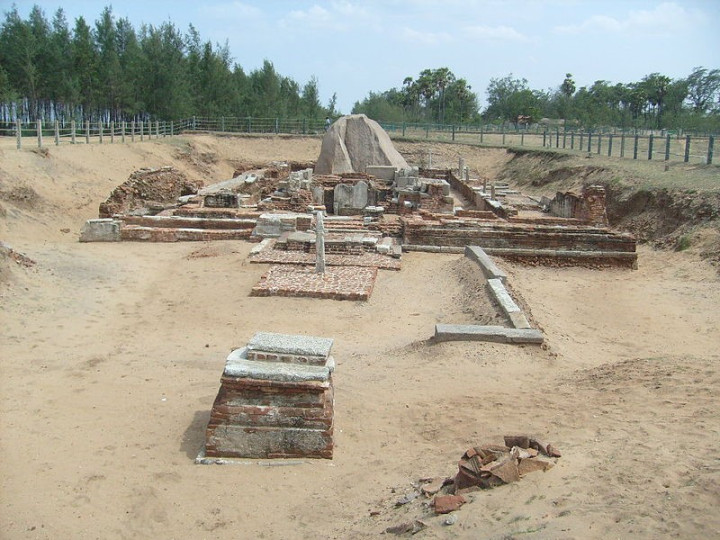For centuries, European sailors who travelled through the Bay of Bengal talked about a mysterious city that they called the Seven Pagodas. Marco Polo mentioned the city in his accounts of Asia, saying that the pagodas were so large he could see them from a great distance away. He even put the city down on his world map.

After him, several other travellers and writers have talked about the Pagodas. Soon the Pagodas became so much a part of the European imagination of the east, that they even had a story about it. The story went like this.
Once, there stood a line of seven temples along the coast that looked out into the Bay of Bengal. Their shimmering copper-covered domes were visible for miles around. The temples were a part of a magnificent city whose people were so happy that it made even the Gods jealous. Indira, the God of rain, was particularly jealous of this famed city. So, he sent down torrents of rain which made the seas swell up and swallow the whole city.
In fact, the Europeans were so fascinated by the tale of their own making that it found a mention in Robert Southey’s epic poem, ‘The Curse of Kehama’
“Their golden summits in the noon-day light,
Shone o’er the dark green deep that rolled between.
For domes and pinnacles and spires were seen
Peering above the sea…”
‘The Curse of Khema’(1810) by Robert Southey
This still isn’t proof that there were ever Seven Pagodas on that coast, but it did prove that the Mamallapuram complex was much larger than originally thought. Then, in December of 2004, a tsunami hit the eastern coast of India. The sea waters receded nearly half a kilometre and large parts of the beach had layers of sand wash away. What was revealed underneath all that sand?

In Mamallapuram a carved stone lion sat on the beach. In another spot, a large stone inscription was found. The most exciting find was in a place called Saluvankuppam, quite close to Mamallapuram. Excavations there revealed the remains of a 2,000 years old temple dedicated to the God Muruga. And where there was a temple, there would have been a pagoda.
You might think that with all this growing evidence, historians would finally agree that that the story of the Seven Pagodas had some truth behind it? Well they won’t. But they do agree that there is a lot more exploration waiting to happen.
So if the story of the seven pagodas was made up, what did European sailors actually see? In all likelihood it was the two domes of the magnificent Shore temple that sits right on the edge of that coast at Mamallapuram.
Want to find out more about Mamallapuram and its mysterious past? Take a walk with the Storytrails Audio Tour, and listen to our stories of ancient kingdoms, enraged Gods, and languages long forgotten.
Archives
- January 2022
- December 2021
- November 2021
- August 2021
- March 2021
- February 2021
- January 2021
- December 2020
- November 2020
- October 2020
- September 2020
- August 2020
- April 2020
- March 2020
- February 2020
- January 2020
- November 2019
- October 2019
- September 2019
- August 2019
- July 2019
- June 2019
- August 2017
- February 2017
- January 2017
- October 2013
Featured Posts
- Tales that pots tell: Keeladi excavations AUGUST 18, 2021
- The Last Grand Nawab: Wallajah FEBRUARY 10, 2021
- How Tej Singh became Raja Desingu of Gingee FEBRUARY 5, 2021
- How Shahjahan seized the Mughal throne JANUARY 28, 2021
- Alai Darwaza – Qutub Minar Complex, Delhi NOVEMBER 21, 2020
- Marking History through British buildings NOVEMBER 17, 2020
- The last great queen of Travancore NOVEMBER 7, 2020
- Brahmi and the evolution of scripts OCTOBER 15, 2020
- The Cambodian King of Kanchipuram OCTOBER 14, 2020
- James Prinsep – the man who read the writing on the wall OCTOBER 10, 2020
- Mariamman – the Village Goddess who travelled SEPTEMBER 30, 2020
- Misnamed Monuments of Mamallapuram SEPTEMBER 28, 2020








